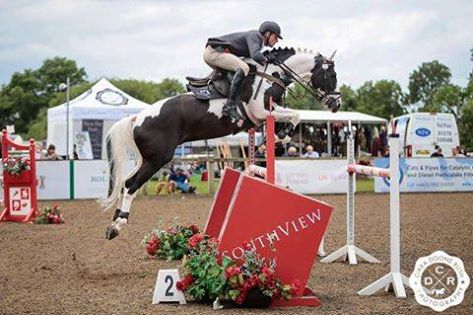Noric Horses
Austria main breeding area: Austria and Bavaria spread: outside the main farming area small Height : 155-165 cm colors : almost all the main applications: riding and carriage horse ride the boys in costume Gailtaler on the bareback Noriker with the iron mace in hand for Kufenstechen in Feistritz .The Noriker is a medium-weight, powerful and perennial mountain cold blood horse . The breeding area includes the mountainous areas of the Austrian and German Alps. The Süddeutsche Cold Blood is one that results from the Norikerpferd cold blood race, in which were from the Second World War, other breeds crossed. A smaller type of Norikers was Abtenauer that in Abtenau was bred, but has since been absorbed into the modern Norikerpopulation Austria.
The Noriker is a medium weight, long rectangular and sure-footed draft horse with a compact body, well muscled and strong foundation. A special feature of the Noriker lies in the variety of colors occurring in addition to the most represented centimes, Brown and foxes in different shades that are marshmallows , tigers - and Take Platt always an eye-catcher. A rarity are rarely derived from the mating of a striped white horses born.
The Noric is a strong, perennial draft horse and is very agile and surefooted breed with calm character. Centuries of selection on these kind personality with a sense of independent work created the balanced temperament of this breed. These characteristics, along with an exceptional step and a good trot sitzbaren make Noriker horse to a safe activity partners for all segments of leisure riding. Noriker both as a sport, riding as well as coach and recently reinstated as work horses.
The origins of the Noriker are not looking as assumed since the end of the 19th century often in Roman legionnaire horses. This view has been shaped by the Austrian veterinarian Dr.Suchanka. Since then, this theory, which is not historically verifiable, repeated unquestioningly. Only the name has Roman roots and is consistent with the geographic range (Roman province of Noricum). The Alpine region was an independent domestication of the horse. The excavations at the (between 800 and 300v.Chr.) Found bridles, bridles, 2achsigen cult weighing and uniaxial Chariots testify to the high level of hippischen culture of the Celts in the Alps, at a time when Rome was not until the birth pangs. In the Middle Ages the Noric horse a pack-horse, and ensured the movement of goods between the Italian seaports and lying beyond the Alps cities like Salzburg and Munich. Very early in the history of the race Norikers played a major role Baroque horses. With the founding of the Salzburg archbishop stud Rief 1565 began the phase of finishing by Neapolitan and Spanish stallions, which exercised its influence to 1806 on the Noric horse. To date, the characteristics of which are visible on the exterior: Ramsköpfe combined with curved top lines and luscious long hair are often found in cents or Mohr heads. The marshmallows (blue mold with black head) get their name directly from the baroque Italian name capo moro. Besides Mohr also heads the tiger drawing has survived to modern times, in contrast to other European breeds. From 1903, this race was run in a herd book and thus obtain a pure culture to this day. Salzburg was and remains the main breeding area of ??the Noric and, according to provisions of the EU lead the origin breed.
Noric in tandem tension In 1960, approximately 80% of the Austrian Noric horses. 1968 in Austria still Noriker 34,510 were counted. Until 1978, the stock fell to a quarter. Due to the increasing use of the sports and leisure sector, the Noric in recent years recovered on new meaning and is not extinct thanks to the rural groups of riders. Today, this breed enjoys strong especially for traditional events and the riding and driving sports great popularity as a workhorse of the Noric is regaining importance.
Volcanic Line: The volcano line since its inception numerically the strongest line. About 50% of the Noric today belong to the volcanic line. She was of the brown stallion volcano 13 635, born in 1887 justified in Pinzgau. The reason for this dominance was that the founding stallions and their successors were representative of the desired type of heavy industry.
Nero Line: Nero-line is the second-largest line, which was founded by the stallion 554 liz Nero. The best known among them is the 1378 Fuchs-Stoissen Nero V/977. Born in 1933 stallion still fully corresponds to the ideas of contemporary Norikerzucht. By type, model, and expression of power and nobility of this stallion has become highly mission statement for the breeding goal of the Noriker. (Quoted Schöfl) be particularly dry, fine expressive head correspond to the desired cold blood aristocracy. The reasons for the proliferation of Nero-line are comparable to those of the volcanic line.
Diamond Line: The Diamond line was up to the fifties of the last century, the second strongest line, but it was subsequently pushed back from the Nero-line. The founder of this line was born 367 Bravo 149, 1877. The name of the line, however, comes from his great-grandson born in 1903 216 diamond 496th These horses are consistently very good type with cold-blooded temperament, noble and with a lot of gaits. Today, the diamond line is represented by only a few Norikern.
Schaunitz Line: Schaunitz-line goes back to the 1888-born stallion Amor Tyrol. Namesake of the line was one of his two sons Schaunitz 255. He was born in 1896. Horses from the Schaunitz line were known in ancient times for their temperament and their gaits. Your lively character is also likely the reason for the problematic situation of this line in the 1980s have been, as the continuation of the line was secured only three stallions. In the recent times is particularly true of the type of horse-Schaunitz the taste of today Norikerzüchters. The lively temperament, upright necks and forward thrust in the movement help to make this formerly endangered branch to new heights.
Elmar-line: The Stallions of Elmar-line are mostly tiger colors, it was established by the 1886-born stallion 80 Arnulf 55th In this line of Baroque influence is most evident. In addition to the typical color-Elmar horses tend to square format, lighter caliber, ramsköpfigen profiles. The proportion of Noriker from Elmar-line is small, nicely drawn tiger are highly prized.



